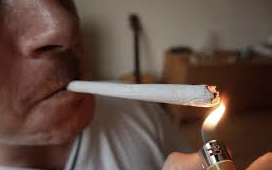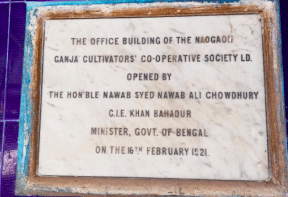Wonderfully engaging article…
British-era Naogaon cannabis society still basks in huge wealth

Mukti Mor is at the heart of Naogaon city that is surrounded by properties of “Ganja Cultivators Cooperative Society” worth several thousands of crores of taka. The society contributed to almost all developments that took place in the city – it always played a crucial role in building mosques, temples, bridges and hospitals in Naogaon.
However, the good old days of the cannabis cultivators are gone as their more than one hundred years old society is plagued by illegal occupations and lawsuits.
According to The History of Naogaon by author and researcher Mohammad Khosbar Ali, and an article by Professor Mohammad Shamsul Alam, the society once had 40 acres of land and some office buildings, including its headquarters at Mukti Mor.
But according to the society, it now has 26 acres of land in Naogaon. But the society says it does not have the details of the properties.
Office Assistant Anisur Rahman now looks after the office of Ganja Cultivators Cooperative Society.

According to him, the society’s properties include 28 buildings, a cold storage, four warehouses, a rest house, a meeting ground, three charitable dispensaries, 11 high schools, three mosques, a temple, seven large ponds and a lake. These assets are scattered in different places of Naogaon Sadar as the properties have been contributing to the development of Naogaon for a long time.
Besides, the cooperative society owned properties in India’s Assam, Kolkata and Bangladesh capital Dhaka. More than Tk5 lakh is still deposited in the Bengal Cooperative Bank in Kolkata.
Shariful Islam, a local researcher and former principal of Naogaon Government College, said the cooperative society was established during the British period. At that time, cannabis was cultivated in Naogaon commercially, and there was government patronage to it. More than 7,000 farmers used to cultivate cannabis on about 10,000 hectares of land. In order to facilitate the cannabis growers, the cooperative society was formed in 1917.

After independence in 1971, Bangladesh signed an international anti-narcotics agreement in 1974, leading to a ban on cannabis cultivation in 1987. The ban left around 50,000 people of 7,000 families unemployed. Later, they switched to paddy, mustard and vegetable cultivation.
According to historians, the main office building of the society at Mukti Mor was built with the model of Writers’ Building in Kolkata. The office building was constructed by importing wood from Nepal. Moreover, the two-storey modern residence for the Excise Superintendent and the two-storied building for the Deputy Chairman enriched the historical and economical importance of Naogaon during the British era.
Researcher Shariful Islam said there is no clear evidence of when and how cannabis cultivation started in Naogaon. It is said that during the East India Company, the first cannabis seeds were brought from Jashore and the first cannabis cultivation started at the then Panchupur upazila (now Atrai and Raninagar upazilas) in Naogaon. Cannabis is considered to be the oldest agricultural product of the subcontinent.
Historians say once cannabis was exported to Assam, Orissa, Uttar Pradesh, Chennai and even to London. From 1918 to 1947, before the Partition of India, an average of 55,000 maunds of cannabis was produced every year as the government used to fetch about Tk66 lakh in revenue.

Usually in June-July, cannabis seedlings were prepared and planted in rows about 9 to 10 inches apart. Cannabis matures in February. After that, the leaves and plants were harvested and sent to the cannabis storages with armed police guard.
At present, there are four cannabis warehouses at Naogaon Narcotics Control Department office, and the area is called “Gajagola Mor”. Four of the warehouses still have more than 226 maunds of cannabis stored. The warehouses are now sealed as the narcotics department owns the land.
Sabuj Chandra Debnath, an inspector at the department, said, “A multi-storey building will be constructed on the land soon.”
The society in doldrums due to internal conflict
According to the district cooperatives department, the society now has about 6,500 members. In 2006, there were issues over the election of the society.
A member named Mofakhkharul Islam then filed a writ petition with the High Court seeking updating the list of shareholders and cancellation of the delegate system (a representative for 50 members). The High Court then issued an interim order, and the Ministry of Local Government, Rural Development and Co-operatives formed an ad hoc (temporary) committee to run the society.
The committee was asked to update the list within three months and select the delegates to look after the assets. But the decision is yet to see the light as the ad hoc committee is still in charge of the properties.
According to the cooperative society, KM Suhrwardi, the then Cooperative Officer of Naogaon Sadar, was tasked with the charge of an auditor as the election was postponed. There were allegations of irregularities and corruption against Suhrwardi and an inquiry committee was formed subsequently. But the report was never made public.

In 1916, the divisional office of the cooperative department was established in Naogaon instead of Rajshahi for cannabis society.
Contacted, Dhirendranath Sarkar, a representative of the district cooperative officer, said, “The assets of the society had been occupied earlier. But this does not happen now. When the term of the ad hoc committee expires, the ministry extends it again.”
District Cooperative Officer Imran Hosen said, “I do not know about the inquiry committee. And, in the last 4-5 years, there have been no irregularities in maintaining the properties of the society.”
Nazmul Haque Jewel, former vice-chairman of the society’s lastly elected committee (2005-2006), said, “Properties of the society still have been occupied by a number of Naogaon parliamentarians, their followers or senior district officials.”
“Our membership was revoked as we protested,” he added.
Researcher Shariful Islam said members of the society once used to get Tk2,000-Tk3,000 annual allowance. The society had student scholarships, medical facilities and veterinary centers. The Liton Bridge over the River Choto Jamuna was also built with the funding of the society. But everything now is just history.

Shariful said the society’s assets have been under constant threat of illegal occupation. Those who came to power have occupied the properties. The Ganja Cultivators Cooperative Society needs proper management to get rid of this.
Milton Chandra Roy, chairman of the ad hoc committee of the society and additional deputy commissioner, said, “There is no scope for irregularity and graft during our stint. Rather, we are working to recover the assets that were occupied previously. I do not know if an inquiry committee was formed or not.”

















